Es devlin’s congregation, an installation of portraits in london
Months after her box of rain ‘Surfacing’ appeared at Art Basel 2024, Es Devlin returns with Congregation. In a conversation with designboom before the unveiling, she unpacks her recent large-scale installation involving fifty portraits of fifty displaced people, those who were forced to leave their homelands because of wars and conflicts. She has created it with the UK for UNHCR, the United Nations Refugee Agency, and the installation is a show of collective drawings, a hint at its title Congregation. It’s going to be inside the St Mary Le Strand church in London between October 4th and 9th, 2024, in time for Frieze London 2024.
These illustrations are accompanied by public choral performances within the surrounding area of the Strand, outside The Courtauld, at 7pm each evening (except Monday). Fifty portraits of displaced people are arranged on multiple levels inside the church. They’re drawn using chalk and charcoal on cardboard, and each portrait is holding an empty box. Es explains to designboom that as soon as the show begins, the one Ekow Eshun curated in collaboration with King’s College London and in partnership with The Courtauld, fifty light paintings that she herself has made are projected onto the box as animations, filling it up with specific objects that are dear to her subjects.
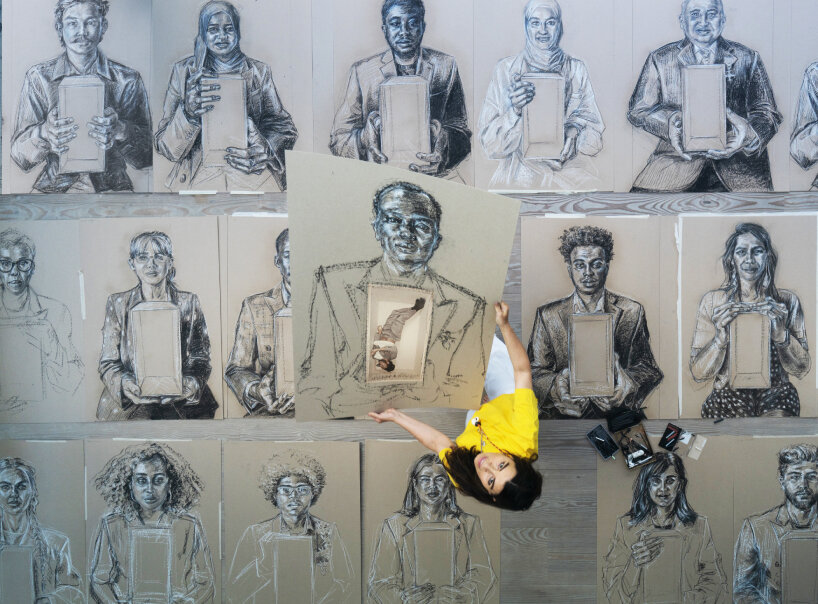
all images courtesy of Es Devlin | photo by Daniel Devlin
portrait Installation inside St Mary Le Strand church in london
During our conversation with Es Devlin, the English artist tells us that she wants Congregation to be a performance, a show. Visitors who book tickets (more here) see a projected film sequence that has been created with the filmmaker Ruth Hogben and choreographer Botis Seva. The empty boxes of the fifty portraits first have dancer Joshua Shanny-Wynter performing in them, all the while viewers listen to the voices of the displaced people, flooding into the St Mary Le Strand church as part of the sound sequence composed by Polyphonia. There’s a sound installation that features poetry by the Kinshasa-born poet JJ Bola, who is also featured in the portraits, as well as extracts from Recomposed by Max Richter: Vivaldi’s Four Seasons.
Es Devlin’s installation in London has also begun with a word. In October 2022, then UK Home Secretary Suella Braverman described asylum seekers traveling on small boats toward the Kent coast as an ‘invasion.’ The artist felt a dissonance she couldn’t comprehend. She asked the UK for UNHCR for help to understand, and they showed her the data on displaced people. She found out that 75 percent of the 176 million displaced people in the world mainly come from Ukraine, South Sudan, Afghanistan, Syria, and Venezuela. ‘They showed me the data, and I thought, well, there must be structures of separation—some structures of ‘otherness’—that we need to look at,’ she shares with designboom, and looking into this otherness is exactly what she’s done.
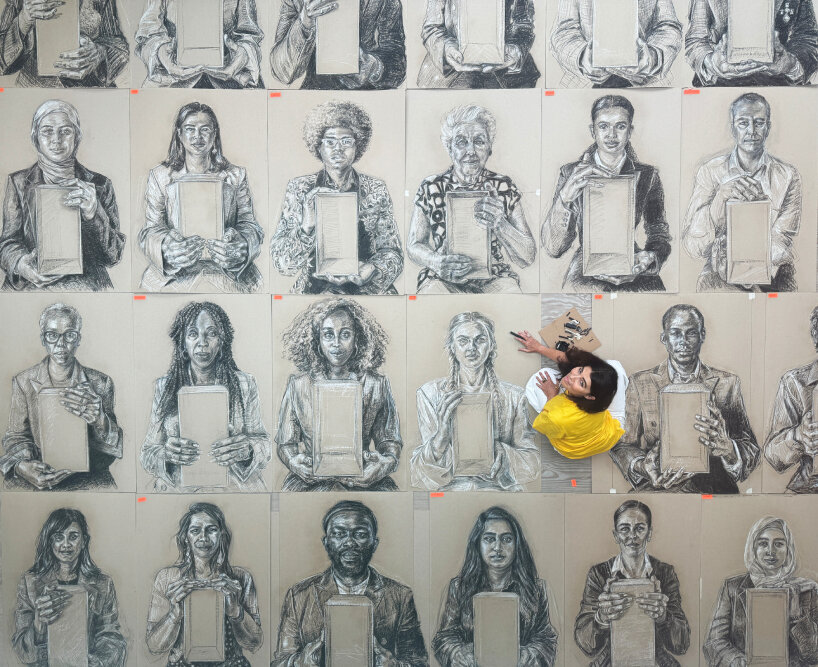
Es Devlin’s Congregation, her London installation with drawings of 50 displaced people | photo by Tayo Shonibare
50 displaced people open up to es devlin for congregation
Fifty strangers with fifty stories, drawn by one artist in her London studio. UK for UNHCR has briefed the subjects and the artist on what happens: they come through her doors by themselves or with a safeguarding person, and Es Devlin only knows their first name and nothing else. She doesn’t know how they’ve arrived in London or what has happened to them. She agrees on one condition: everyone wears a suit or dresses up as if it were a formal occasion. ‘I did it because I wanted to destabilize my preconceptions, judgments, and biases. I wanted to have an encounter with a face to begin with,’ she explains to designboom. One by one, they enter her studio and sit before her.
It’s quiet. No one’s talking. Both of them are just listening to Max Richter’s recomposition of Vivaldi’s Four Seasons playing in the background. In the lull of violins, they look directly into each other’s eyes without speaking, at times crying just by listening, looking, and being in the present solitude. When the recording reaches track 14, Shadow 1, Es Devlin pauses the tracks. She grabs the microphone and says, ‘Tell me about yourself.’ For five months, between April and August 2024, fifty displaced people opened up to Es Devlin. They’ve told her who they are, what they’ve been through, and how they’ve been forced to leave their home countries and re-establish themselves in a foreign land, culminating in a large-scale installation in London.
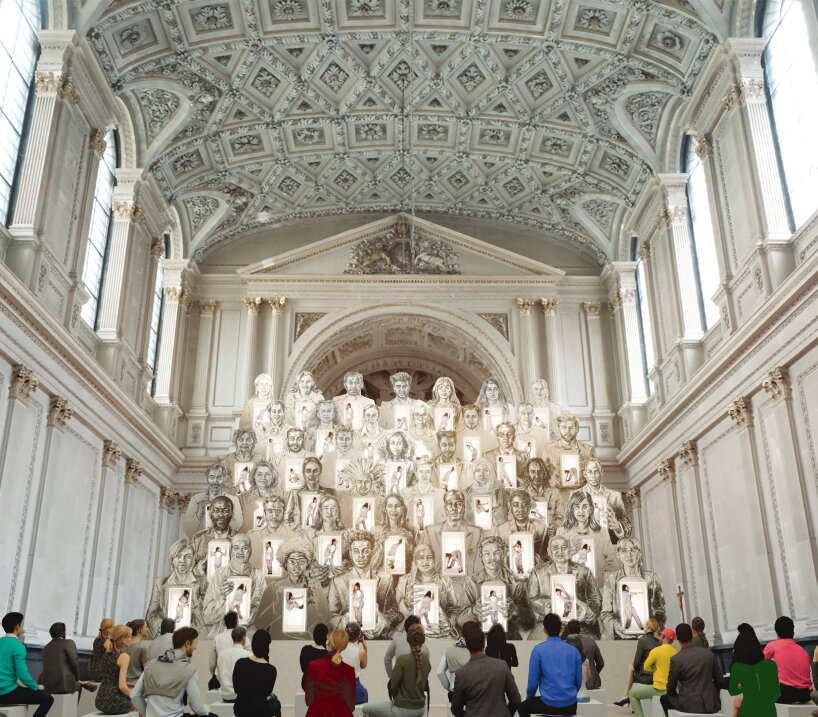
St Mary Le Strand in London hosts Es Devlin’s installation, Congregation
At one point in our interview, Es Devlin admits she doesn’t like the word ‘refugee.’ ‘It’s started to accumulate associations that aren’t helpful,’ she tells designboom. ‘I was looking for new words and thought: what about those who bring gifts, like the three kings? What if we start looking at this community not fearfully about what they’ll take, but excited about what they’ll bring? We could look at anyone being born that way. Any new birth migrates from pre-life into life through the womb—they’re still on a journey. Are they going to bring gifts, or are they going to take? We don’t know whether they’re coming through a birth canal or on a small boat. Let’s look at people like that.’
In a series of fifty portraits and a large-scale installation in London, visitors walk within the St Mary Le Strand church and meet the displaced people and learn their stories. As Es Devlin shares with designboom, they’re not encountering a person; they’re encountering a drawing of a person. Even so, visitors can hear their voices as narration and read their experiences as first-person essays in the accompanying book. For the artist, it feels like a gathering, setting the table for dinner and wondering who’s going to get along with whom. ‘I’m introducing fifty of my community in London to this new community of viewers,’ she admits to designboom, and in our conversation below, she spares us her time to understand how her Congregation has come to life.
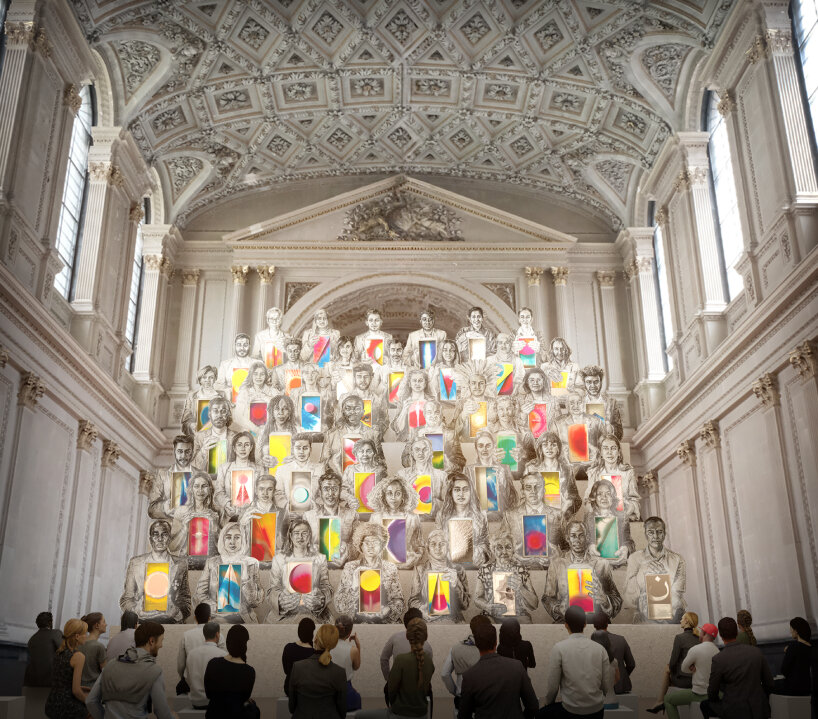
the show projects animated light paintings onto the empty boxes that the subjects are holding
INTERVIEW WITH ES DEVLIN
designboom (DB): We were reading through the project and saw that Congregation is a collaboration with the UNHCR. Has this partnership been going on since the last time we saw each other at Art Basel 2024?
Es Devlin (ED): It actually began on February 24th, 2022, with the Ukraine war. At the time, I was working on the piece outside Tate Modern, where I was drawing 243 Londoners who are more than humans. I drew 243 London species, and I was working with the Wildlife Trust. At the end of that project, I changed. I had observed London species in detail for four months, not sleeping much, just drawing. I felt my hand achieve this porosity between my veins and the veins on a bat’s wing, between my skin and the scales on a lizard’s back, between the shape of my knuckles and the shape of a bird’s wing. I noticed that, at the same time, this devastating war broke out in Ukraine, and our country suddenly seemed to be showing porosity toward Ukrainian people, which I hadn’t felt before.
We had recently experienced a kind of brittleness in our discourse around identity, in relation to Brexit and Europe, and this felt like a refreshing shift in tone and intention countrywise. I started to sense dissonance, though, because the discourse was still getting louder. In October 2022, Suella Braverman, our then home secretary, used words like ‘invasion’ of small boats on the Kent coast. I found a real dissonance I was trying to reconcile. How, on one hand, am I reading an article that celebrates schools welcoming thousands of people from Ukraine, and yet people coming from Syria and Afghanistan on small boats are ‘invaders?’ I didn’t understand. I needed help. So, I went to the UNHCR and said, ‘Please help me understand.’
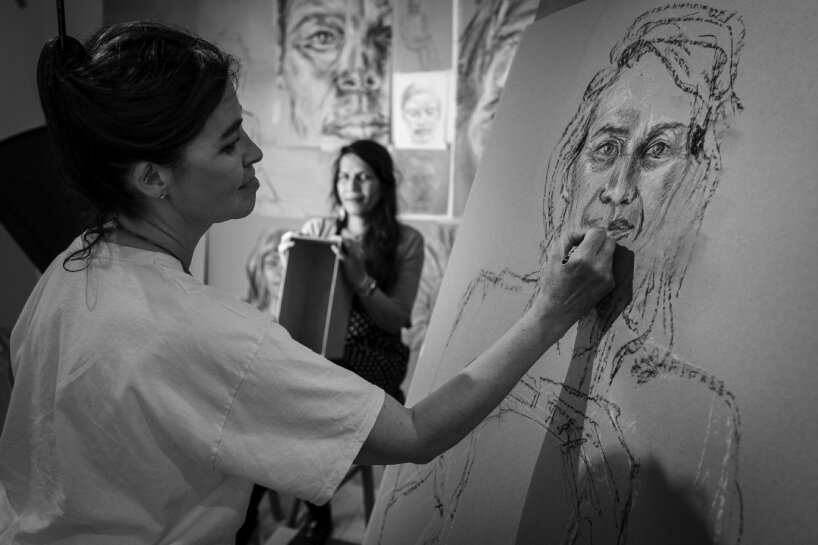
Shika Thibault in portrait session with Es Devlin for her installation in London | photo by Daniel Devlin
ED (continued): They showed me the data and said, of all the displaced people, of which there are 176 million in the world at the moment, 75% are from five countries. That is Ukraine, South Sudan, Afghanistan, Syria, and surprisingly, Venezuela, which I wasn’t aware of. Of those, 40% are being housed in just five countries, including Iran, Turkey, Jordan, and Colombia. I thought, okay, you have six million displaced people from Ukraine and six million from Syria. Why are we not feeling the same porosity towards Syrians, for example?
When you get into the details, you have three million displaced from other countries, including Eritrea and Somalia. They showed me the data, and I thought, well, there must be structures of separation—some structures of ‘otherness’—that we need to look at. Having drawn these animals and learned so much, I thought I better start drawing in order to learn. I did the project to perceive, draw, and learn about my own structures of separation, my own biases. So with the UNHCR—and to answer your question—that’s how the project began.
DB: And what happened next?
ED: The UNHCR then agreed to the portraits. They introduced me to 50 people from 28 countries. They chose people they thought would be appropriate for this encounter. Each person was briefed that the encounter was with a stranger, so they knew that when they arrived at my door, I would only know their first name. I would not know anything else about them—where they came from, whether they had come six months ago on a small boat or 60 years ago on a Kindertransport. I didn’t know anything at all. All I knew was that at some point they had come to London seeking refuge, but that’s all I knew, and there was a vast variety of circumstances.
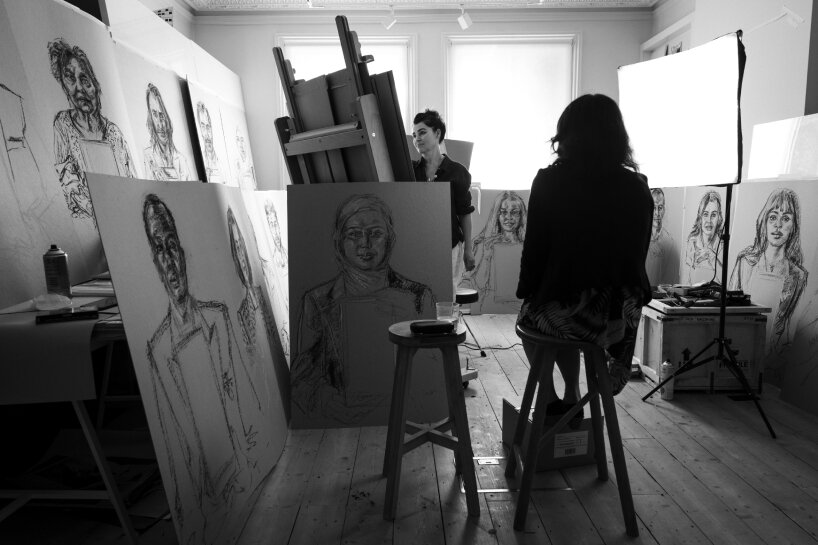
Trinh Tu in portrait session with Es Devlin for Congregation, her installation in London | photo by Daniel Devlin
ED (continued): The idea worked this way: they sat, often with a UNHCR safeguarding person, or sometimes alone, in my studio in this very room. I gave each person the same empty box. I played the same piece of music, Max Richter’s Four Seasons, so we wouldn’t talk. We didn’t talk at all. I asked them to look straight into my eyes, which is quite difficult, even for us to do now in this interview. It’s not easy to sustain the gaze of another, whoever they are. In the process of drawing, we sometimes both started crying, just from the music and looking at each other.
What I encountered—much like with the animals—was that if you really stop and gaze at another living being, in the end, if you meditate on it, you perceive a microcosm of the whole universe in that being. I really perceived that and felt that I was in the presence of someone who encompassed the entire universe. I felt that about grasshoppers when I was drawing them, though they were from photographs, and it was more distant because I was just getting into the geometry. But it was the geometry of their forms where I felt that infinity.
I was drawing the people, the presence of the gaze with the music, Four Seasons, and the sunlight passing across their faces while I was illustrating them. At 44 minutes in Max Richter’s track, my alarm would go off. I’d stop the track, get the microphone, and say, ‘Tell me about yourself.’ There was a sense of relief on both sides. They were desperate to tell their story, and I was desperate to hear it. The portrait just sat there, as if saying, ‘Why were you concentrating on this when it’s all about that?’
